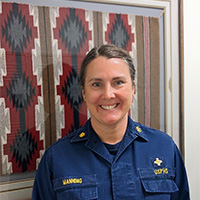April is Occupational Therapy Month, a time to celebrate the contributions of occupational therapists as important members of our health care teams across the Indian health system. This year’s theme, “Occupational Therapy: Empowering Everyday Living,” highlights the work of OTs as they strive to improve the quality of life for our patients each day. Most people do not fully understand the role OTs play in the health care setting. This could be because occupational therapy shares many similarities with physical therapy. However, there are distinct differences between each discipline, such as education requirements and approaches each takes with a patient's rehabilitative care.
OTs work with people of all ages to participate in daily living activities or live better with injury, illness, or disability. This is accomplished through the completion of a holistic evaluation of the patient to determine what is impacting their ability to complete everyday activities such as dressing, grooming, cooking, cleaning, working, and participation in leisure activities. This holistic view of patients allows OTs to determine if the patient has a physical, psychological, emotional, or social issue that is contributing to their inability to fully participate in daily life. The holistic focus on the patient often allows OTs to identify issues that other professions may overlook.
Occupational therapists utilize science driven, evidence-based techniques to get patients back to everyday living at their highest level. OTs within IHS take a public health approach throughout the treatment process and provide education on disease management, health promotion, injury prevention, and mental wellness. They may teach a patient how to use equipment to make dressing easier or modify activities to decrease strain on certain areas of the body to decrease pain. They may also instruct patients on how to adjust their environment to make activities easier, change sleep positions or nighttime routines, or adjust their work station to decrease body strain for decreasing pain or improving function. Some IHS facilities have both outpatient and inpatient occupational therapy services. Inpatient OTs work with hospitalized patients who have difficulty completing dressing, bathing, transfers, and self-feeding, and train patients in the safe use of adaptive equipment use as needed.
Occupational therapists are also known as the upper extremity experts as they receive specialized training in how to treat injuries of the upper extremity. OTs frequently fabricate custom orthosis which aligns the angle between the bones and muscles for patients to provide relief. They also treat patients with upper extremity injuries, both conservatively and post-operatively. Approximately 85% of all certified hand therapists are OTs with several CHTs being employed by IHS and many more working towards certification. In order to become a CHT, the therapist must have at least three years of experience treating the upper extremity, 4,000 hours of patient care, and pass a very difficult comprehensive exam.
In order to become licensed to provide care, an occupational therapist must go through extensive training and education. Occupational therapists that work within the IHS system have to be very knowledgeable with strong treatment skills and the ability to provide a diverse array of treatments to a variety of ages. Occupational therapy is a profession that is very unique in providing holistic care to get our patients across Indian Country back to everyday living. If you see an occupational therapist, thank them today!



